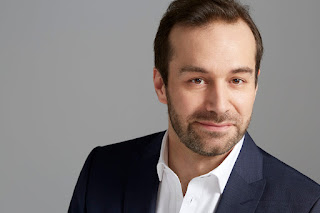French connections: Trumpet virtuoso and guest conductor make them with ISO
 |
| Native Parisian Fabien Gabel shed light on French music. |
After the relative novelty of having a trumpeter as guest artist, then hearing a scintillating, little-
Amazingly, it wasn't, even though the ISO played the popular work (in one of the composer's other "Firebird" suites) as recently as last summer under another dynamic podium guest, Kevin John Edusei. This weekend, with Fabien Gabel conducting, the hints of modernism were just as evident, but showing an advance on Stravinsky's inheritance from his revered countryman Nikolai Rimsky-Korsakov.
Stravinsky credited his boldness in creating a later masterpiece ballet, "The Rite of Spring," to the inspiration he received from the music of the Frenchman Florent Schmitt. A suite from Schmitt's ballet "La tragédie de Salomé" occupied a half-hour of the ISO program's second half (to be repeated at 5:30 this afternoon). The original work dates from 1907, and its encapsulation of the heroine's sensuality contrasts with the power-mad Salome depicted in Richard Strauss' near-contemporary opera.
Played after the Schmitt piece, music of "The Firebird" (1910) reveals that the young Stravinsky absorbed more of the burgeoning modernism of Paris in the 20th century's first decade than is generally credited. Friday's performance of the suite revealed a gift for color beyond the influence of Rimsky-Korsakov and a pictorial richness that depended more on new harmonies and rhythms than upon the Russian heritage.
From the first, "La tragédie de Salomé" had the insinuating charm typical of French music. Roger Roe's English-horn soloing in the suite's "Prelude" was firmly lyrical yet rightly soft-focused. Schmitt may have derived some of his manner from Debussy, which seemed most evident in the third section ("The Apparitions on the Sea"), but the reigning aesthetic sounded more expressionist than impressionist. The orchestration occasionally registers as if on an emotional Richter scale, a special feature being a gravitas-laden, double-reed saxophone relative called the sarrusophone, played by the versatile Mark Ortwein.
Schmitt's swerve from Debussy emerges mostly in the rhythmic element, "which may be supple or jagged but always commands a principal position" (in the apt phrase of Grove Dictionary's entry on Schmitt). The concluding "Dance of Terror" had coordinated luster as well as galvanic force. Gabel and the ISO indicated indeed that this was astonishingly the "Rite" avant la lettre.
The orchestra played the work as if long familiar with the piece, but it was the ISO's first time Friday. This is the sort of fitness the ensemble regularly puts on show these days. In the current long schedule of guest conductors, the ISO responds well to the best of them. Gabel joins that company this weekend.
That was confirmed by Friday's "Firebird" suite. No episode was trotted out as if it were merely about color, though there was plenty of that. The French stage tradition of linking dance and drama got vibrantly displayed from the mystery of the opening measures, rising from the depth.
Later in the suite, there was uncanny tension in the sustained string tremolos between the lullaby and the hymn of general rejoicing celebrating the Firebird's lifting of the evil spell. There was so much good wind playing that I didn't have to wait breathlessly for the balm of Ivy Ringel's bassoon solo in the "Berceuse." Just as it impressed me at the end of the pandemic-shortened '20-'21 season, here it was also soul-lifting. No surprise that Gabel invited the principal bassoonist to take the first of the solo bows at the end.
 |
| Håkan Hardenberger probed the deceptive insouciance of the Tomasi concerto. |
Finally, but definitively in the "last but not least" category, there's the excellence of the weekend's guest soloist: Håkan Hardenberger, a trumpeter of international distinction whose long career includes a host of specially commissioned works. Outside that arena, Henri Tomasi's Trumpet Concerto is a modestly proportioned work of considerable ingenuity. It has nothing of the heft of Tomasi's older contemporary Schmitt, and it also makes its appeal without theoretical baggage. The music often has the debonair quality of Poulenc.
The Swedish virtuoso displayed peerless agility, nimbleness of phrasing and expression (aided by the score's requirement of two different mutes to supplement the open horn) and a full, flawless tone. The audience was told this was the North American premiere of the concerto's original version, so it's not the one you may have heard in one of the few recordings Wynton Marsalis made as a classical trumpeter long ago.
On Friday, Tomasi's expansive cadenza was notable for its variety and Hardenberger's ingratiating partnership with the snare drum. Coordination with the orchestra was undimmed by such brisk demands as the work's urbane finale, flecked with percussion outbursts. Small wonder there, as Gabel was trained as a trumpeter from the age of 6 (an unusually early start for a brass instrumentalist). Yet Gabel's well-honed affinity as a conductor for the standard repertoire was brought forward at the start of the concert. There he drew from the orchestra the compact significance of the high-romantic Austro-German tradition with a vigorous performance of Brahms' Tragic Overture.



Comments
Post a Comment